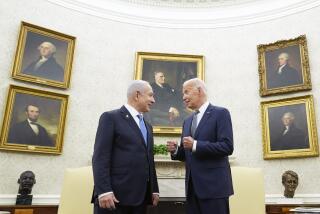Satellite Photos : CIA Reportedly Still Giving Spy Data to Iraqis
- Share via
WASHINGTON — While the Reagan Administration secretly sold arms to Iran, it continued to provide Iraq with intelligence gleaned by U.S. spy satellites, sources said.
In August, the CIA established a direct, top-secret Washington-Baghdad link to provide the Iraqis with better and more timely satellite information. One source with firsthand knowledge said the Iraqis receive the information from satellite photos “several hours” after a bombing raid in order to assess damage and plan the next attack. This source said the intelligence information is “vital” to Iraq’s conduct of the war.
CIA Director William J. Casey met twice this fall--once in October and again in November--with senior Iraqi officials to make sure the new channel was functioning and to encourage more attacks on Iranian installations, the sources said.
Iraq has mounted a series of air attacks against Iran in recent months, concentrating on oil terminals, oil pumping stations and power plants--all with the intent of destroying Iran’s economy and its ability to continue the war, which entered its seventh year this fall.
Attempt at Stalemate
One well-placed U.S. government official said that the Administration policy of arms for Iran and satellite intelligence for Iraq was “a cynical attempt to engineer a stalemate” in the war.
White House spokesman Daniel Howard said Sunday: “We don’t comment on intelligence matters.”
Sources said the information from U.S. satellites was not supplied regularly until sometime in early 1985. For the next 18 months the information was supplied through Washington channels as needed by the Iraqis, particularly after an Iraqi bombing raid.
The direct Washington-Baghdad link, established in August, was accomplished by way of a special intelligence unit in the U.S. Embassy in Baghdad, one source said. Two sources said that the Iraqis now receive selected portions of the actual photos that are taken by U.S. reconnaissance satellites and on some occasions, U.S. reconnaissance aircraft.
Surprise Bombing Raid
In mid-August, just after the direct channel was installed, Iraq executed a surprise bombing raid against the Iranian oil terminal at Sirri Island that Iran supposedly thought was safe from attack.
Sources said that in early October, Casey requested a meeting with Iraqi Foreign Minister Tarik Aziz, who was at the United Nations in New York. A few days later, the sources said, Casey’s request was granted and he met Aziz and Iraq’s ambassador to the United States, Nizar Hamdoon. Casey, who reportedly was aware of the still-secret Iranian arms dealings, told the two Iraqis he wanted to make sure that they were happy with the flow of intelligence, and he also encouraged more attacks on economic targets, the sources said.
Later in October, the United States sent a fourth shipment of arms to Iran, and on Nov. 2, hostage David P. Jacobsen was released. The next day, a pro-Syrian Lebanese magazine disclosed the first details of the secret U.S.-Iran initiative.
After the disclosure, Ambassador Hamdoon requested and received another meeting with Casey. The two met in Washington about two weeks ago, the sources said, and Casey had no apology to offer for the Iran initiative but pledged that the secret channel for satellite data would remain open to Iraq.
More to Read
Sign up for Essential California
The most important California stories and recommendations in your inbox every morning.
You may occasionally receive promotional content from the Los Angeles Times.












